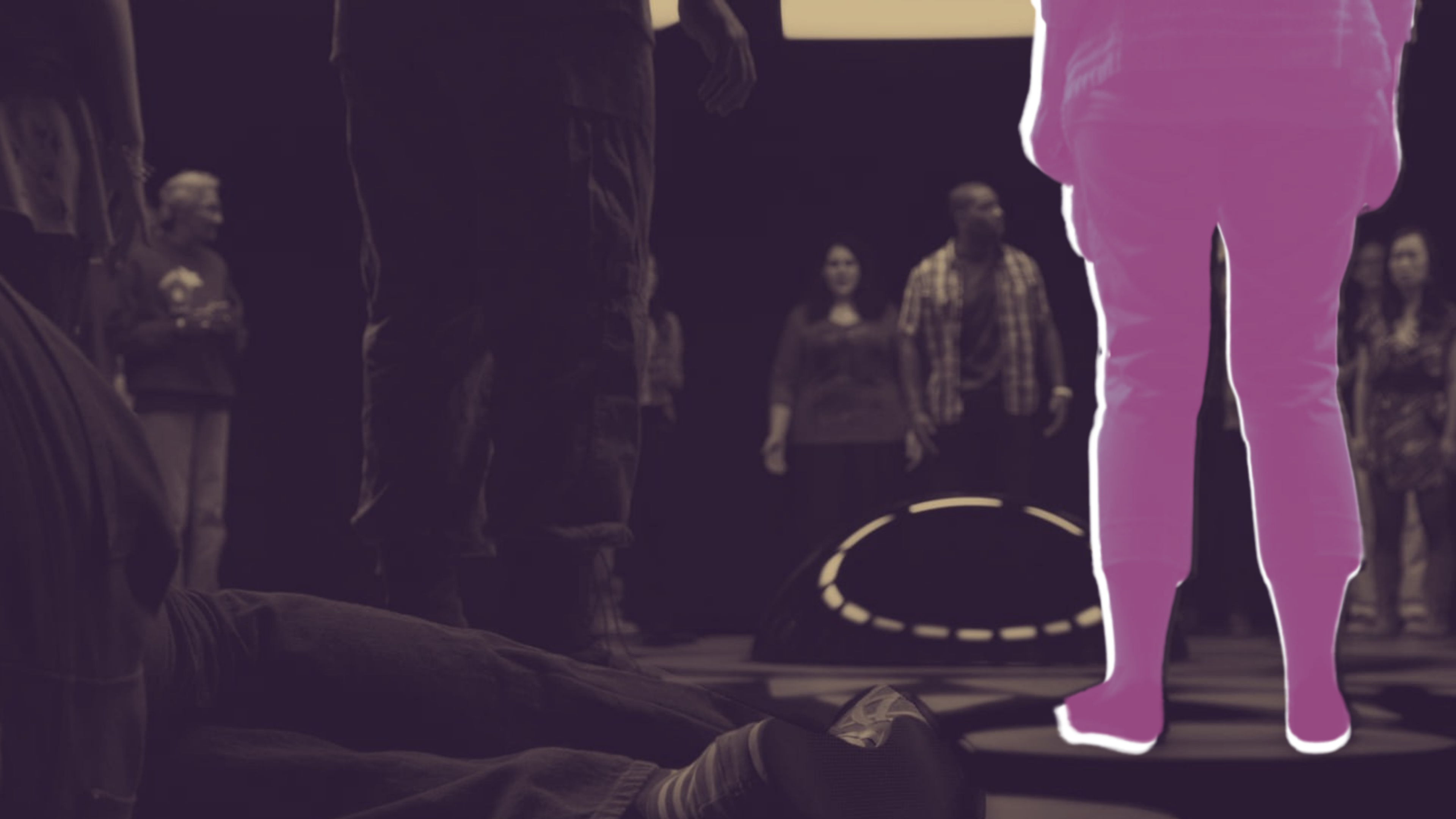Editorials
‘Circle’ Calls Our Conscience To a Vote
August 12th, 2021 | By Ciara Moloney

Aaron Hann and Mario Miscione’s 2015 film Circle opens in a dark room. Fifty people are waking up, confused and disorientated. They don’t know why they’re here or what’s going on. They’re standing arranged in concentric circles around a black dome with red lights. Then there’s a flash, and they start dying.
Every two minutes, one of them is killed. It can be from a beam of light that comes from the dome. It can be if someone tries to leave, stepping outside the small red circle under their feet. But every two minutes, someone dies. The early parts of Circle are nervous chaos, as the group’s attempts to figure out what the hell is going on are interrupted by another death. They talk about what they remember from before they woke up here. They discuss if there are any connections between the people in the room. They theorize about how they might buy time. But every two minutes, flash, another body drops.
The collection eventually figures out that it’s a vote. A device implanted in their hands allows each person to move a white light to point towards one of the people in the room. The person who gets the most votes dies. There are more rules, which they figure out trying to come up with an alternate exit strategy. You can’t vote for yourself. If no one votes, someone is killed at random. If they force a tie, they have to vote again. Another two minutes, another dead body. It becomes a grim inevitability. Soon they’re not talking about a way to stop it. They’re talking about who should die.
It’s an ensemble movie where the ensemble is constantly shifting. Every so often it feels like a protagonist has emerged, only for them to disappear in the next round. Other characters go by unnoticed, only to come to the forefront unexpectedly. Most of the characters are unnamed and most are played by unknown actors. In a lot of movies where characters are killed off, you have a good sense of who will survive: you watch a slasher movie and easily identify the Final Girl. But Circle gives you no such reassurance. Everybody is on the table, and the clock is ticking.
Circle is an entry in the proud tradition of “people debating moral issues in a room” school of sci-fi. It plays out more or less in real-time in this one dark room. There are some effects, but nothing flashy. The film’s structure drops the audience into the room with no context, scrambling to figure out what’s happening just like the characters are. More and more information is revealed gradually through the room’s conversation. The truth remains pretty slippery: there’s plenty of reason to wonder who is trustworthy. In the film’s last act, two people are revealed to have been lying about being married because they thought it would advantage them in the vote. Anyone could be lying, and we wouldn’t have any way to tell.
Critics, in both positive and negative reviews, described Circle as an elongated episode of The Twilight Zone. For their part, co-directors Aaron Hann and Mario Miscione cite 12 Angry Men as their main influence. Like 12 Angry Men, Circle consists of anonymous strangers debating what to do. Like a Twilight Zone episode, it delves into real-world social issues in a sci-fi horror context. It’s also reminiscent of a game show, made horrific. People in a circle in a dark room voting each other off is just one step removed from The Weakest Link.
As it becomes clear that there’s no way to avoid the two-minute deadline, factions emerge, disintegrate and re-mold. The first major decision is to target the oldest people. They would have died first in “real life”, so they should be the first to die here. When they get below 70-year-olds, though, this becomes contentious, and the biggest advocate for killing the oldest people gets killed next.
Bigotry in the room is risky. Subtler forms can benefit you, but overt forms can cause a backlash. A police officer accuses a tattooed Latino man of beating his girlfriend, and when the man admits it, he is killed next. Later, when a black man calls out the racial dynamics at play in who is getting killed, the police officer goes on a racist rant, and he’s the next to drop. When a businessman pressures a lesbian to out herself, there’s really genuine trepidation that she’s going to be killed for it – but the businessman is killed instead. (Another man explains that his son is gay, and there’s nothing wrong with him.) The same dynamic plays out when one character accuses a woman of being a pornstar. An immigrant who doesn’t speak English will “obviously” be next when the woman who was translating for him dies. A perfectly nice woman introduces herself and gets killed straight after because she made the mistake of saying she doesn’t have any kids. So many of the killings are a values test, taking the moral temperature of this cross-section of American society.
You could do this as satire or black comedy, but Circle opts for a quietly observational approach. The film invites us to watch this play out, reveling in its cynicism. It isn’t non-judgemental, precisely, but judgment is ours to make without the filmmakers’ thumb on the scale. It’s amazing how quickly the characters–and the audience–adjust to the idea that someone will die every two minutes. It’s just a matter of who deserves it.
The debate begins to center on a little girl and a pregnant woman. Some people strongly assert that they’re off-limits and no one can vote for them. But an alternate argument takes hold, too. As long as the kid and the pregnant woman are protected, that makes the odds worse for the rest of them. Eventually, it’s going to get down to two. Who knows what will happen then. But the longer the kid and the pregnant woman survive, the less likely you are to make it that far. One guy hassles the kid about her grades (good, but not straight As), and the woman about if she works and if she’s married. (No answer.)
A one-armed man, a Marine, and a guy called Eric (Michael Nardelli) become the leaders of the protect-the-kid-and-the-pregnant-woman faction. The movie pulls its punches a bit on the Marine. He is so adamant that he would never kill the kid, and no one even idly wonders if he killed kids in Afghanistan. It’s strange for a film that’s so inquisitive about human nature to have such blinders on when it comes to the US military. But the ending is so bleak that I forgive it easily.
Eric, the little girl, and the pregnant woman are the last three. Eric says they will have to decide which of the two of them will survive. The little girl volunteers through her tears, wanting to save the baby. Eric says she’s being very brave. They’ll go together, he says, getting ready to step off into oblivion.
And then, in the same second the little girl steps off, he votes for the pregnant woman. They both die and he survives. It’s a shock that borders on a blackly comic punchline. The moral dichotomy that seemed to exist—between the protect-the-vulnerable faction and the screw-‘em faction—is upended. Eric was just playing a longer con. Who knows who else might have been? It’s a stinging indictment of not just Eric, but everyone. No matter how noble their intentions may have appeared.
The only real exception, the only real nobility, is a sixteen-year-old boy named Seán. Seán sacrificed himself because he didn’t want to kill anyone. The businessman calls him Scott in his last moments.
Visit our Editorials page for more articles like this. Ready to support more original horror criticism? Join the Certified Forgotten Patreon community today.



